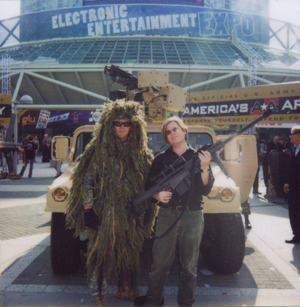 A Review of Half Life: A Novel
A Review of Half Life: A Novel
Shelley Jackson
HarperCollins Publishers
2006
440 pp.
$24.95
Shelley Jackson puts on a very intriguing and fetching hat or two to write of a conjoined twin in her novel Half Life. Narrator Nora Olney shares much of her spine and all of her limbs with Blanche, who has been slumbering for a decade and a half; these two share their status as a “twofer” with quite a few others in a more radioactive but otherwise similar alternative world. The narrative, which incorporates clippings and lists and has the circuitous wobble of Tristram Shandy, matches its jaded tone to events that are sometimes outrageous, sometimes perfectly true to the typical American experience, and sometimes both. While it takes a while to narrate the conception and birth of Nora and Blanche, the novel is given its impetus by the document that is included first: Nora’s authorization to undergo “The Divorce” and to become an ordinary “singleton” by having Blanche surgically, and fatally, removed.
Perhaps surprisingly, given the overt bodily obsessions and explorations that permeate Half Life (and Jackson’s earlier work – her hypertext Patchwork Girl; her short story collection The Melancholy of Anatomy; her story “Skin,” tattooed on volunteers), it is the spaces and structures of this novel that seem most remarkably compelling and vivid. While the play of the body, Nora’s quest, and her relationship with other characters work well, the landscapes, cities, and towns (along with an intricate and intimate dollhouse) seem to out-strange even the physiognomy of the protagonist. The addition of a twofer scene to San Francisco and London splits these cities from themselves in an uncanny way. Also intriguing are a small Nevada town, Grady, and a nearby place, Too Bad, that hovers on the edge of ghost status, not to mention the desert plot called Penitence with its curious purpose.
Half Life is a deft and deep work; the narrator’s understated, Victorian pen is, oddly, perfectly apt for what is at the core of this book – not sinistrality, politics, or philosophy, which are all certainly to be found among the many layers, but a sense of wonder at human life and the world. Plus, there is a conversation about squid, inadvertent marmite-throwing, and a complete textual delivery of the interrupting cow knock-knock joke.
But it is with more than one twinge that I read Half Life, for I recognized the mapping that Jackson had in mind for her roman à clef. Twofers congregate in San Francisco, where they have film festivals and seek to foster acceptance of their culture. When Nora seeks a clinic for her twin-severing procedure, protesters bar the way and threaten her safety. Important distinctions are found between twofer “pre-ops” and singleton “post-ops.” At the risk of belaboring the obvious, I will unfold the most important correspondences that are intended by the author: Twofers represent authors of electronic literature while singletons signify traditional print authors. Thus, Nora’s quest for “The Divorce” is the story of Shelley Jackson’s forsaking the computer for the book.
This is a preview of
Jackson’s Rad Half Life
.
Read the full post.



 Pure rumor that apparently originated in Electronic Gaming Monthly, but which I can’t resist propagating: A Rez sequel or Rez-like game is in development for the Wii by Tetsuya Mizuguchi. You can read a discussion of Rez in McKenzie Wark’s
Pure rumor that apparently originated in Electronic Gaming Monthly, but which I can’t resist propagating: A Rez sequel or Rez-like game is in development for the Wii by Tetsuya Mizuguchi. You can read a discussion of Rez in McKenzie Wark’s  A Review of
A Review of 
 The quirky weekly “Consumed” column in the NYTimes Sunday magazine
The quirky weekly “Consumed” column in the NYTimes Sunday magazine